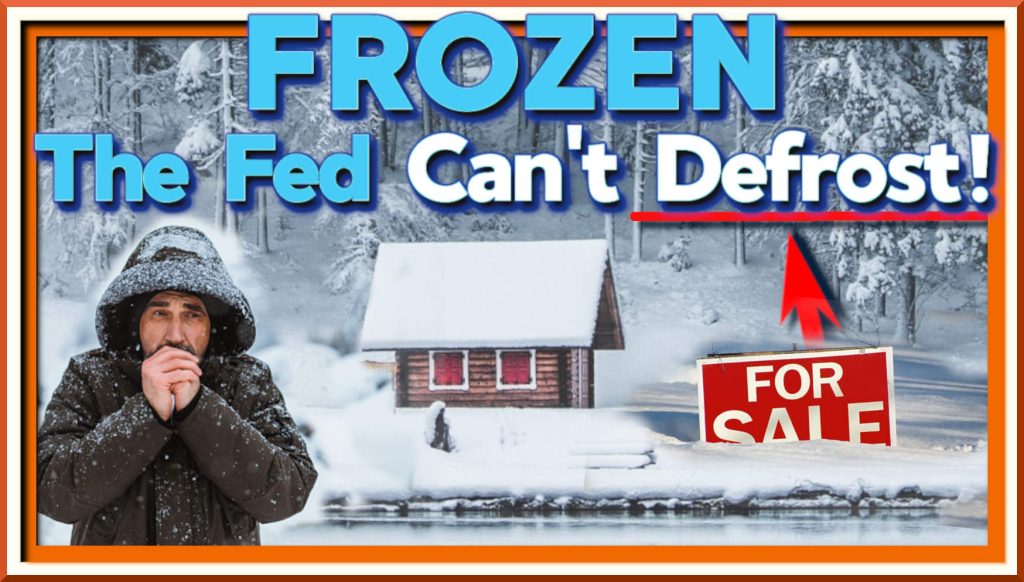Frozen Market Can Be Saved!
The United States real estate market is currently experiencing an unprecedented freeze. With insufficient homes available, many buyers are compelled to pay higher-than-normal prices and face a significantly reduced selection. This situation has generated a palpable sense of uncertainty among both buyers and sellers. Consequently, the market has entered a state of paralysis, making it increasingly challenging for potential homeowners and investors to navigate the landscape.
The pressing question on everyone’s mind is whether the Federal Reserve can step in to lower long-term interest rates and revitalize the market. This article delves deeply into the current state of the real estate market, illuminating the factors contributing to this freeze and exploring potential solutions that the Government and the Federal Reserve could implement to stimulate growth.
The current freeze in the real estate market can be attributed to a combination of factors, including rising interest rates, economic instability, and a general lack of consumer confidence. As interest rates climb, the cost of borrowing increases, making it more challenging for prospective buyers to secure affordable mortgages. This situation has led to a decrease in demand, with many potential buyers opting to wait for more favorable conditions. Additionally, economic uncertainty has caused both buyers and sellers to adopt a cautious approach, further contributing to the market’s stagnation.
In response to this crisis, there is growing speculation about the potential role of the Federal Reserve in revitalizing the real estate market. The Federal Reserve, as the central bank of the United States, wields significant influence over the nation’s monetary policy and interest rates. By adjusting these rates, the Fed has the power to either stimulate or cool down economic activity. In the current scenario, a reduction in interest rates could lower borrowing costs, making it more attractive for potential buyers to enter the market and potentially thaw the frozen transactions.
However, the decision to alter interest rates is not without its complexities. Lowering rates can indeed boost borrowing and spending, but it can also lead to inflationary pressures, which the Fed must carefully manage. Therefore, any intervention by the Federal Reserve would need to be meticulously calibrated to ensure it supports the real estate market without triggering unintended economic consequences. This delicate balance forms the crux of the discussion surrounding the Fed’s potential involvement in addressing the current market freeze.
Beyond the Federal Reserve’s actions, the Government also has a toolkit of measures at its disposal to stimulate growth in the real estate sector. Fiscal policies, such as tax incentives for homebuyers or subsidies for first-time buyers, could provide much-needed relief and encouragement for market participation. Additionally, investment in affordable housing projects and infrastructure development could create a more favorable environment for both buyers and sellers. These governmental interventions, when combined with the Fed’s monetary policies, could offer a multifaceted approach to revitalizing the real estate market.
For homeowners, the current market conditions present a unique set of challenges and opportunities. On one hand, those looking to sell may find it difficult to attract buyers in a cautious and uncertain market. On the other hand, current homeowners with fixed-rate mortgages are somewhat insulated from the effects of rising interest rates, potentially providing a sense of stability amidst the turmoil. Investors, too, must navigate this complex landscape, weighing the risks and rewards of entering a market characterized by frozen transactions and uncertainty.
As we examine the intersection of real estate and monetary policy, it becomes evident that the future of the frozen real estate market hinges on a series of interconnected factors. The decisions made by the Federal Reserve and the Government will play a pivotal role in shaping the market’s trajectory. Will the Fed take decisive action to lower interest rates and spur market activity? Will the Government introduce targeted fiscal policies to incentivize buyers and stabilize the market? These questions remain at the forefront of our discussion as we explore the potential paths forward.
In conclusion, the US real estate market finds itself at a critical juncture, with frozen transactions and uncertain buyers and sellers dominating the landscape. The potential intervention of the Federal Reserve and the implementation of governmental measures offer glimmers of hope for a market recovery. By carefully analyzing the options available and understanding the broader economic implications, we can gain insights into what the future may hold for the real estate sector. Join us in this video as we navigate the intricate relationship between real estate and monetary policy, and uncover the potential solutions to thaw the frozen market.
🤔Thinking About Selling? 🏘️ 📞Call or 📱Text: (949) 354-4464 📨 Email: [email protected] ⬆️⬆️⬆️⬆️⬆️⬆️⬆️⬆️⬆️⬆️⬆️⬆️⬆️⬆️ Your Real Estate Professional! 👀 🏠
REALTOR® DRE#01332662 Realty Masters & Associates NEW CLIENTS WELCOME! 🖥 https://GrantLoel.com

